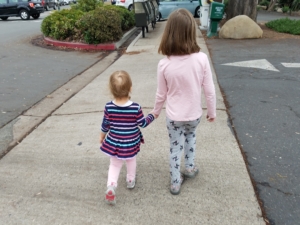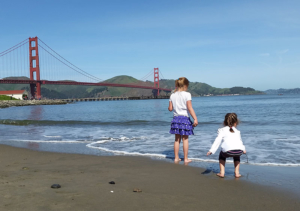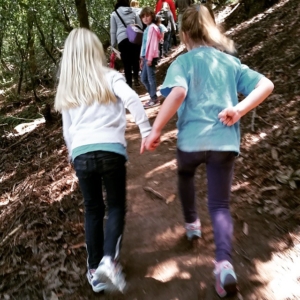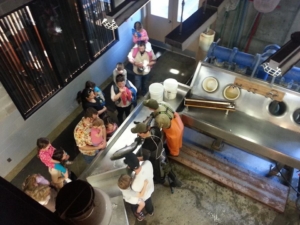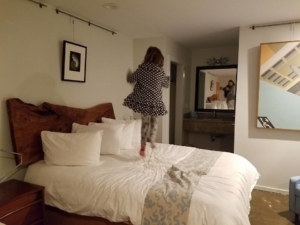
Fully “exploring” the Astro.
Our most recent family getaway comprised one night in a room at The Astro Motel, a brand-new property near my home in Northern California.
The place soft-opened in October after a pretty major renovation; the new owners redesigned it to celebrate mid-century modern flare. While some of the furniture and wall decorations are vintage, the place is mostly no-frills. In our room, a small flat-screen television hung on a wall bracket in the corner above a modest mini-fridge. Over near the sink—which was exposed to the rest of the room—a tiny plastic hairdryer was nestled into a cradle high on the wall.
It’s worth noting that the nightly rate of $160 included complimentary coffee and muffins in the morning. Guests also have access to a decent-sized library of children’s books such as “Snowy Day” and “The Giving Tree.”
In short, the Astro is a veritable poster child for family travel.
What makes the place so great for traveling families? It’s affordable. It’s authentic. It’s clean. It’s efficient. Also, it’s fun. After more than eight years of traveling with kids, I’ve determined that these five attributes are all we moms and dads *really* need from hotels when we travel. Anything else is superfluous; nothing more than a profit source for the parent company.
That last sentence was meant to be contentious. By stating that anything beyond these attributes is “superfluous,” I’m intentionally stirring the pot. Put differently, I’m calling out the dozens of hotel brands that double-down on perks they consider to be family-friendly but charge an arm and a leg for the privilege of staying there.
Sure, there are parents who feel a certain sense of comfort with “free” plush toys for the kids at check-in. Yes, there are moms and dads who love a property-wide kids’ menu. I’m sure somewhere on Earth, there even are guardians who aren’t completely creeped out with the idea of a butler coming to your hotel room to tuck in your children and give them warm cookies in bed. For me, however, it’s time to rethink what’s most important in family travel. It’s time to focus on what really matters to actual families.
. . .
This post has been a long time in the making. If you’ve followed this blog with any regularity, you probably noticed that I haven’t written anything in a while. That hasn’t been by accident. I’ve taken a sabbatical, if you will. A sabbatical to learn more about how people travel with their kids.
This research was inspired in part by my buddy Erin Kirkland, and began in my role as a board member of the Family Travel Association. There I had the benefit of talking to travel agents and vendors about what they think traveling families want. Armed with these examples, I sought anecdotes from families, chatting with real-world parents I’ve met on playgrounds, in museum cafes, and online.
Conceptually, the two sides weren’t that far apart; everyone agreed travelers want meaning from travel.
The similarities ended there. For vendors (and, subsequently, agents), there seemed to be a correlation between cost and meaning—the more of an “investment” made on a hotel, the more meaningful the subsequent experience likely would be. For moms and dads, however, the relationship wasn’t necessarily direct; even among those moms and dads who have the means to spend big bucks on family travel said they try to reserve the bulk of their budget for doing stuff.
This told me that most families prefer not to spend big bucks on hotels. It means they’d opt for modest accommodations if it meant a richer experience overall.
I asked my interview subjects for specifics, and dozens upon dozens of them threw out brand names such as Motel 6 and KOA as their go-to “lodging” on family trips. Others swore by Best Westerns, and Red Roof Inns. Still others hailed vacation rentals. Many people even said they still purchase family trips through travel agencies and online travel agencies where bundling hotel with airfare and activities can save money. (It’s worth noting after that kind of statement that I’m no longer on the payroll at Expedia, which sells bundled trips; I’m just reporting what people told me.)
Normally this is the part of a post where I’d call upon my training as a journalist and drop in some scientific data to back up my research and prove my point explicitly. But I don’t have stats to sprinkle into the narrative. I haven’t conducted a study to determine the socioeconomics of the average family traveler in America. To my knowledge, this kind of data doesn’t exist. Not yet, at least. (Get on it, FTA!)
What I do know is this: As life in America becomes increasingly expensive, traveling does, too. Traveling with a bunch of humans can get extra-spendy. I leave Thursday for a week-long road trip with my daughters, and one of the reasons we’re not stopping at Universal Studios Hollywood is because it would have cost us nearly $600 to spend five hours in the park.
With price tags like these, it’s no wonder families are opting to cut costs whenever they can.
Of course herein lies the great disconnect. Families are trying to cut costs on the nuts and bolts of travel to maximize their on-the-ground experience, while big brands are paying big bucks to market high-dollar products to everyone as the kind of travel that is most fulfilling. The result, for the most part, is aspiration overload. Most family travel coverage is chock-full of safari narratives or stories that extol the virtues of hotels that cost $700 per night. This is travel for the 1 percent. It’s nothing but an extension of lifestyle (or, as the case may be, perceived lifestyle).
Open up the latest issue of Travel + Leisure or Conde Nast Traveler and tell me different. Even The New York Times is guilty of this phenomenon (though Freda Moon’s occasional “Frugal Family” pieces for the Travel section are a shining example of what great and thoughtful family travel writing can be).
IMHO, most mainstream family travel writing is completely out of touch with the way actual families travel.
. . .
Before you start calling me a hypocrite, I admit it: I’m guilty of perpetuating this disconnect. That’s why I needed time away. It’s why I needed to go back to basics and hit the streets. It’s also why I’m starting off the new year with this post. Because from here on out, Wandering Pod will look and feel a little different.
Put differently, I vow to cover family travel the way most actual families do it.
What does this mean, exactly? It means more posts about the ins and outs of planning, more details about finances. It also means more stories about the journey, about the meaning behind the “bucket list.” I’ll write more pieces about challenges we face, particularly as the parents of a child who has sensory integration issues yet yearns to see and explore and experience more. Even my descriptive pieces will change a bit—I’ll still show you readers what makes destinations worthwhile, but I also will put that into context, too.
Overall, my new aim is to add more value to the conversation, and get even more real about what it means to hit the road with kids in today’s day and age. On a week-to-week basis, it means covering more places like the Astro—places that are affordable, authentic, clean, efficient, and fun. On a post-by-post basis, it means adding more dollar amounts to every service piece, so readers can see exactly how much each of my experiences costs.
The goal of this glasnost is simple: To get real. If I spotlight a hotel perk, I’ll spotlight it because it’s legitimately different and cool, not because I think that’s the story the hotel wants to tell (or because some PR person in a cubicle in Midtown Manhattan asked me to share). If I wax poetic about a promotion, it will because the promotion provides undisputable savings and value—to customers of all kinds. If I spread the word about a niche vacation rental site, it will be a niche vacation rental site with prices middle-class American families can actually afford.
Sure, from time to time, I’ll still cover high-dollar stuff. This summer, we Villanos will visit Flathead Lake Lodge in Montana, and our stay is my compensation for a huge copywriting project.
When I see value, I also might even write about theme parks (though I’ll buy my tickets at Costco).
For the most part, however, my new standard will be the Schoolyard Test: If the moms and dads in our local schoolyards wouldn’t invest in particular travel products on the next school break, I don’t really want to be writing about them here.
Consider this my resolution for Wandering Pod in 2018. Hopefully it will make my voice in the industry even more reliable. Hopefully it will inspire you to think about family travel in a new way, too.


